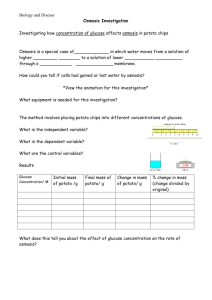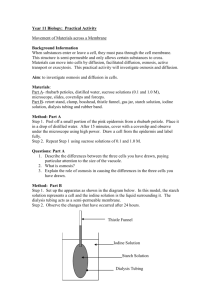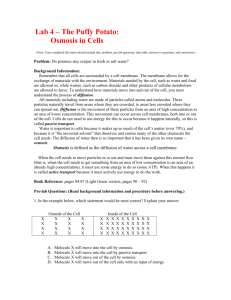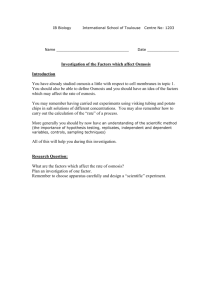Diffusion- Osmosis Lab Report Guidelines: Report Due Monday
advertisement
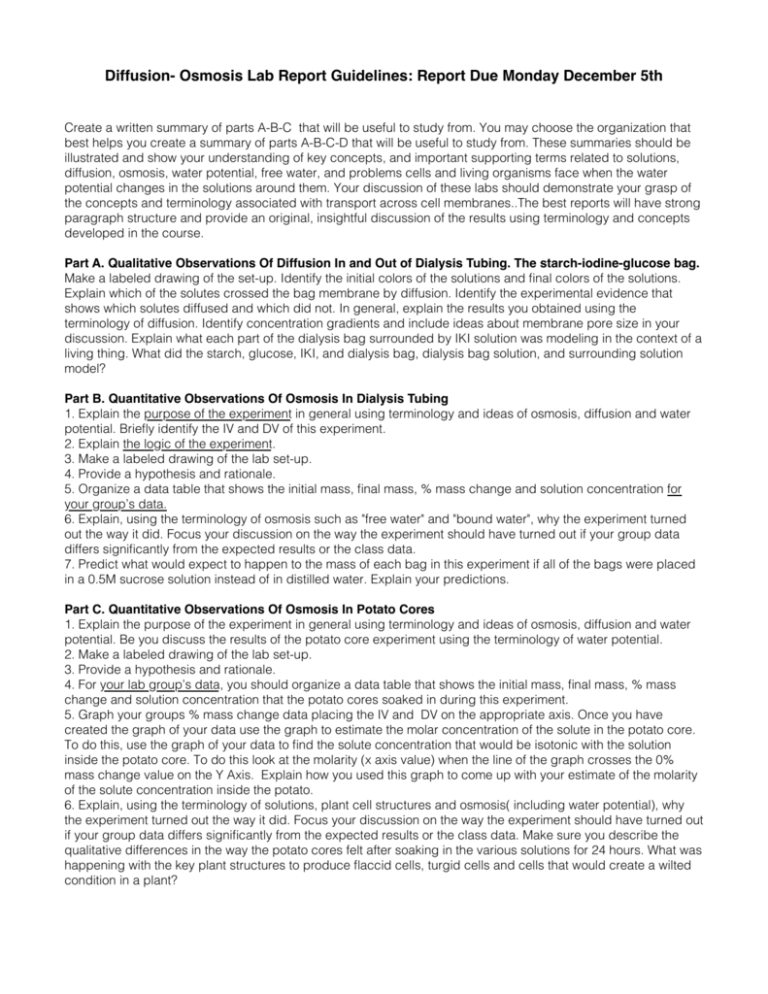
Diffusion- Osmosis Lab Report Guidelines: Report Due Monday December 5th Create a written summary of parts A-B-C that will be useful to study from. You may choose the organization that best helps you create a summary of parts A-B-C-D that will be useful to study from. These summaries should be illustrated and show your understanding of key concepts, and important supporting terms related to solutions, diffusion, osmosis, water potential, free water, and problems cells and living organisms face when the water potential changes in the solutions around them. Your discussion of these labs should demonstrate your grasp of the concepts and terminology associated with transport across cell membranes..The best reports will have strong paragraph structure and provide an original, insightful discussion of the results using terminology and concepts developed in the course. Part A. Qualitative Observations Of Diffusion In and Out of Dialysis Tubing. The starch-iodine-glucose bag. Make a labeled drawing of the set-up. Identify the initial colors of the solutions and final colors of the solutions. Explain which of the solutes crossed the bag membrane by diffusion. Identify the experimental evidence that shows which solutes diffused and which did not. In general, explain the results you obtained using the terminology of diffusion. Identify concentration gradients and include ideas about membrane pore size in your discussion. Explain what each part of the dialysis bag surrounded by IKI solution was modeling in the context of a living thing. What did the starch, glucose, IKI, and dialysis bag, dialysis bag solution, and surrounding solution model? Part B. Quantitative Observations Of Osmosis In Dialysis Tubing 1. Explain the purpose of the experiment in general using terminology and ideas of osmosis, diffusion and water potential. Briefly identify the IV and DV of this experiment. 2. Explain the logic of the experiment. 3. Make a labeled drawing of the lab set-up. 4. Provide a hypothesis and rationale. 5. Organize a data table that shows the initial mass, final mass, % mass change and solution concentration for your group’s data. 6. Explain, using the terminology of osmosis such as "free water" and "bound water", why the experiment turned out the way it did. Focus your discussion on the way the experiment should have turned out if your group data differs significantly from the expected results or the class data. 7. Predict what would expect to happen to the mass of each bag in this experiment if all of the bags were placed in a 0.5M sucrose solution instead of in distilled water. Explain your predictions. Part C. Quantitative Observations Of Osmosis In Potato Cores 1. Explain the purpose of the experiment in general using terminology and ideas of osmosis, diffusion and water potential. Be you discuss the results of the potato core experiment using the terminology of water potential. 2. Make a labeled drawing of the lab set-up. 3. Provide a hypothesis and rationale. 4. For your lab group’s data, you should organize a data table that shows the initial mass, final mass, % mass change and solution concentration that the potato cores soaked in during this experiment. 5. Graph your groups % mass change data placing the IV and DV on the appropriate axis. Once you have created the graph of your data use the graph to estimate the molar concentration of the solute in the potato core. To do this, use the graph of your data to find the solute concentration that would be isotonic with the solution inside the potato core. To do this look at the molarity (x axis value) when the line of the graph crosses the 0% mass change value on the Y Axis. Explain how you used this graph to come up with your estimate of the molarity of the solute concentration inside the potato. 6. Explain, using the terminology of solutions, plant cell structures and osmosis( including water potential), why the experiment turned out the way it did. Focus your discussion on the way the experiment should have turned out if your group data differs significantly from the expected results or the class data. Make sure you describe the qualitative differences in the way the potato cores felt after soaking in the various solutions for 24 hours. What was happening with the key plant structures to produce flaccid cells, turgid cells and cells that would create a wilted condition in a plant?

